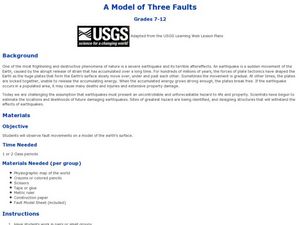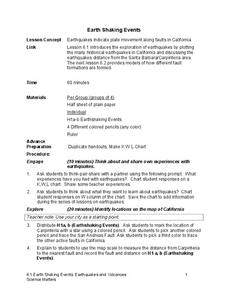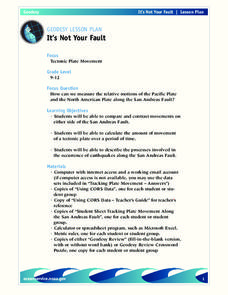Science Matters
Spaghetti Fault Model
Does increasing the pressure between two moving plates provide a stabilizing force or create more destruction? The hands-on lesson encourages exploration of strike-split fault models. The sixth lesson in a 20-part series asks scholars to...
Curated OER
A Model of Three Faults
Students observe fault movements on model of the Earth's surface, find fault movements associated with different types of plate boundaries, research examples of non-plate boundary faults, and research and report on the types of faults...
Curated OER
A Model of Three Faults - Part One
Students construct a fault model using the Fault Model Sheet imbedded in this plan. They create a 3 dimensional model of the Earth, and use dashed lines to illustrate where the fault lies. A discussion of faults follows the completion of...
Science Matters
Up and Down Fault Blocks
The Sierra Mountains in Nevada and the Tetons in Wyoming originally formed as fault block mountains. In order to visualize these fault blocks, pupils use construction paper to create layers of earth. They cut the paper models and form...
Curated OER
Teaching About Plate Tectonics and Faulting Using Foam Models
Young scientists learn about plate tectonics and the three different types of faults (normal, reverse, and strike-slip) using foam models. The activity also covers common types of locations where these faults are found.
Curated OER
Types of Faults
This set of black-line diagrams of the three different types of faults can be used with your upper elementary earth scientists. Simply have them color the layers to show where the land once lined up. Another use for this resource would...
Science Matters
A Model of Plate Faults
The San Andreas fault is one of the longest fault zones in the world. In a series of 20 lessons, the fourth lesson has pupils use a paper model to recreate various types of plate faults. Each is held in position then drawn into a science...
Science Matters
Fault Formations
The San Andreas Fault moves about two inches a year, approximately the same rate fingernails grow—crazy! The third lesson in the series allows for hands-on exploration of various fault formations. Through the use of a Popsicle stick,...
Curated OER
Stressed to a Fault!
Eighth graders describe how stress builds up in the Earth's crust by the movement of tectonic plates. In groups, they relate the three types of stresses to the types of plate movements and explain how the stress causes faults to form. ...
Curated OER
Comparing the New Madrid and San Andreas Fault Zones
In this faults instructional activity, students use an earthquake reference sheet to find the numbers for a modified Mercalli and Richter scale. They compare the San Andreas Fault zone and the New Madrid fault zone on the United States...
Curated OER
Earthquakes And Fault Lines
Students discuss major causes of earthquakes and identify famous fault lines, access and map information about ten largest earthquakes in world from 1989 to 1998, and theorize about location of these earthquakes as they relate to Earth's...
Curated OER
New Zealand South Island Fault Model
Students explore world geography by creating a scientific model in class. In this New Zealand lesson, students research the geography and fault lines of the South Island in New Zealand. Students utilize foam board, arts and crafts and a...
Curated OER
Plotting Earthquakes
Students plot earthquakes on a map. In this lesson on earthquakes, students will explore recent earthquake activity in California and Nevada. Students will plot fault lines and earthquake occurrences on a map.
Curated OER
Model of a Normal Fault
Students understand what a normal fault is and why it causes an Earthquake. In this normal fault instructional activity, students create a model of a normal fault.
Curated OER
Fault Features
Students discuss the different kinds of faults in the earth's crust and examine photos of the San Adreas Fault. Working in groups, they experiment with fault making by placing fabric in a pan and filling the inside with wet dirt. When...
Appalachian State University
The Fault in Our Stars: A Movie Study Guide for Eighth Grade Language Arts, Social Studies, and Science
How would you spend your last days with a loved one? The movie guide for The Fault in Our Stars prompts scholars to compare important scenes from the novel to the film and contains background information about the author, guided...
Science Matters
Earth Shaking Events
The world's largest measured earthquake happened in 1960 in Chile, reaching a terrifying 9.5 magnitude on the Richter Scale. The second lesson in the 20-part series introduces earthquakes and fault lines. Scholars map where previous...
Curated OER
Earthquakes: Second Grade Lesson Plans and Activities
What causes earthquakes? Second graders learn about stresses from plate movement with a set of hands-on activities. After tracing fault lines on a map with yarn, class members create a paper plate model of Earth to show its layers and...
Curated OER
It's Not Your Fault
Students determine how to measure the movement of the plates along the San Andreas Fault. Students calculate the movement of tectonic plates over a period of time and describe the processes involved in the occurrence of earthquakes along...
Curated OER
Bigger Faults Make Bigger Earthquakes
Students experiment with string to visualize how earthquakes are created. Using various lengths of string, students determine which earthquakes lasted the longest and hypothesize why. Students look at a fault map and determine which may...
Curated OER
It's Not Your Fault
Young scholars study the San Andreas Fault, calculate its movements, and compare the movements on both sides. In this earthquake instructional activity students use the Internet to track movement, and calculate movement using a...
Curated OER
Faults At Tyson Lagoon
In this seismic trench worksheet, students write two short answers to questions based on fault photos and diagrams from the Hayward fault.
Curated OER
Sandwich Stratigraphy
Two activities are included in this resource. In the first, junior geologists model sedimentary rock layers, apply the Law of Superposition, and demonstrate folding and faulting of the Earth's crust. The model is technically a sandwich....
American Museum of Natural History
Earthquakes Tremors From Below
Earthquakes are really no one's fault. A thorough lesson explains the different types of earthquakes how they happen. Learners interact with the online lesson to simulate earthquakes and examine their results. The lesson is appropriate...
Other popular searches
- Types of Faults
- Folds and Faults
- Earthquake Faults
- Paper Models of Faults
- Faults and Folding
- Reverse Faults
- Stress and Faults
- Geology Folds and Faults
- Strike Slip Faults
- Plate Boundaries Faults
- Folds Faults
- Normal Reverse Faults

























